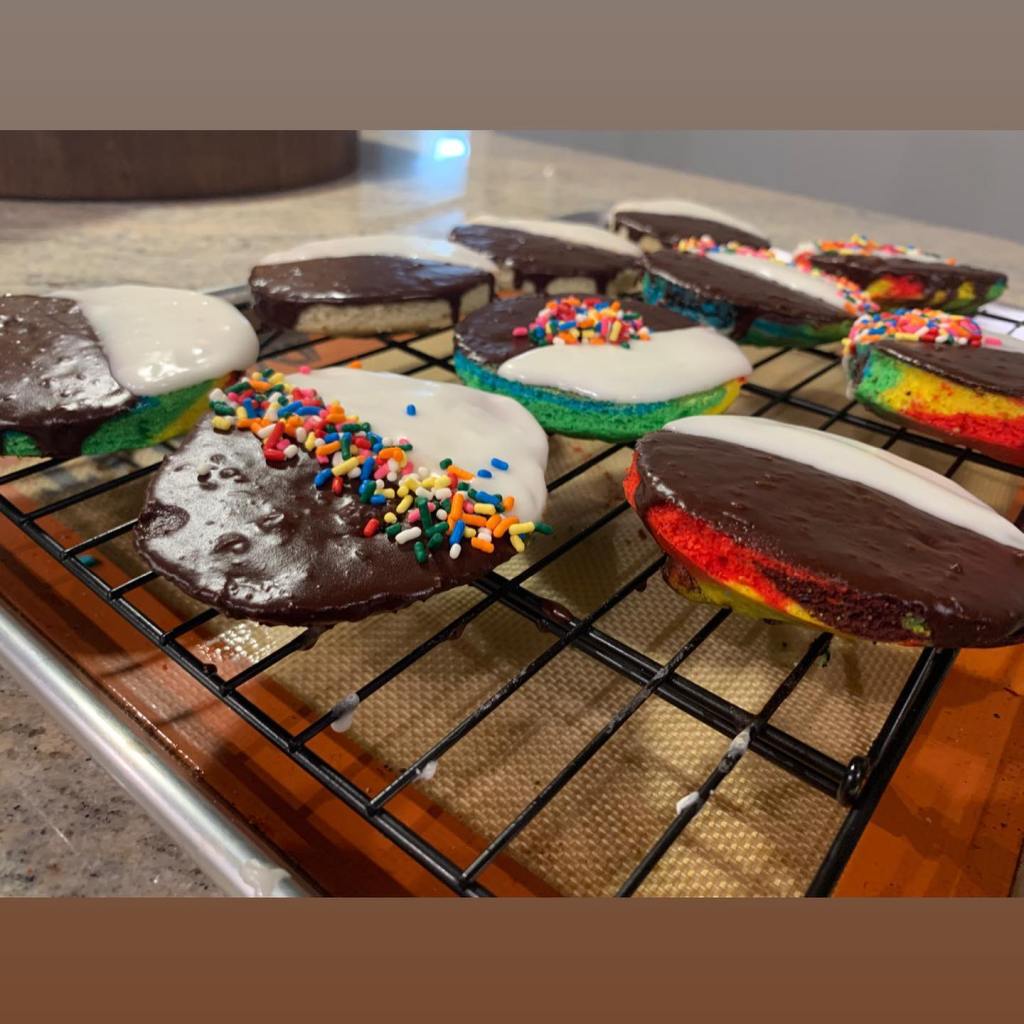
Every year around the holidays, I get requests to make Italian Seven Layer Cookies, Venetian, Rainbows–whatever you may call them. They’re a staple in an Italian-American/Tri-State Area of New York. I live in the Poconos, so these are hard to come by–we don’t have lavish bakeries, so it’s often requested of me to bake these, and I do it lovingly. They’re my favorite cookie. However, they are time-consuming to make, so this year, I experimented with making even LARGER batches of these so it’s worth the effort. Nowhere on the internet other than here shows you this, so with a little trial and error, I would like to share with you this recipe that is near and dear to my heart. I am also going to share some tips along the way. These cookies are not for beginner bakers, so beware!
The recipe and tips I’ve used over the years are from Smitten Kitchen. The recipe is the same generally everywhere you look. What I like about this recipe is that the egg whites are whipped up separately (some don’t), which I think lightens the batter and makes it easier to spread and airier in the end. I think these have the authentic almond flavor without tasting artificial, which I appreciate. I’ve included my tips as well as other tips that I learned researching these cookies, so please actually read them! They’re a fussy cookie, so do it right!
If you have a kitchen scale, I highly recommend using it for not only this but all baking. Measuring in grams gives you immense accuracy! I think it’s especially helpful to weigh all your ingredients, particularly the jam.
Below I am including the conventional recipe, which uses a 9″ by 13″ jelly roll pan. I also have my version which makes a larger, bakery-style size batch!
Italian Seven Layer/Rainbow Cookies
Servings: Makes about 5 dozen cookies (or more, if you cut them as small as I did); the double batch makes about 10 dozen!
Time: These take at least 11 hours from beginning to end, most of it inactive, but make sure you have a good 2 to 3-hour window. I recommend making these at nighttime so you can wake up to cookies!
Regular Recipe, designed for a conventional 9″ by 13″ jelly roll pan
4 large eggs, separated
1 cup (200 grams) granulated sugar
1 (8-ounce or 225-gram) can almond paste
1 1/4 cups (10 ounces, 285 grams, or 2 1/2 sticks) unsalted butter, softened
1 teaspoon (5 ml) almond extract
2 cups (260 grams) all-purpose flour
1/2 teaspoon kosher salt
25 drops red food coloring
25 drops green food coloring
1 (12-ounce or 340-gram) jar apricot preserves, heated and strained (or you can do 6 ounces of raspberry preserves and 6 ounces of apricot if you want the combination like I use)
7 ounces (200 grams) semi-sweet chocolate chips or pistoles
Ingredients for Half Sheet Pan Size (Be sure to use a half sheet pan, which is 18″ by 13″)
8 large eggs, separated
2 cups (400 grams) granulated sugar
2 (16-ounce or 450-gram) almond paste
2 1/2 cups (20 ounces, 570 grams, or 5 sticks) unsalted butter, softened
2 teaspoon (10 ml) almond extract
4 cups (260 grams) all-purpose flour
1 teaspoon kosher salt
50 drops red food coloring
50 drops green food coloring
1 (12-ounce or 340-gram) jar apricot preserves, heated and strained
1 (12 ounce or 340 gram) raspberry preserves, heated and strained (seedless if possible!)
14 ounces (400 grams) semi-sweet chocolate chips or pistoles
Put oven rack in middle position and preheat oven to 350°F. Butter a 13- by 9-inch baking pan (or half sheet pan, if you’re going large and in charge) and line bottom with wax paper, leaving a 2-inch overhang on 2 ends, then butter paper.
Beat whites in a mixer fitted with whisk attachment at medium-high speed until they just hold stiff peaks. Add 1/4 cup sugar a little at a time, beating at high speed until whites hold stiff, slightly glossy peaks. Transfer to another bowl. Note: If you’re making the larger batch, you’ll need double, so you’ll need to add 1/2 cup of sugar a little at a time.
Switch to the paddle attachment, then beat together almond paste and remaining 3/4 cup sugar (1 1/2 cups of sugar, if going large) until well blended, about 3 minutes. Add butter and beat until pale and fluffy, about 3 minutes. Add yolks and almond extract and beat until combined well about 2 minutes. Reduce speed to low, then add flour and salt and mix until just combined.
Fold half of egg white mixture into almond mixture to lighten, then fold in remaining whites gently but thoroughly.
Divide batter among 3 bowls. Stir red food coloring into one and green food coloring into another, leaving the third batch plain. Set white batter aside. Chill green batter, covered. Pour red batter into prepared pan and spread evenly with offset spatula (layer will be about 1/4 inch thick). Note: I don’t chill my batter–I don’t find it makes a difference, but I am including it here anyway.
Pro Tip About Spreading: Spreading the batter evenly is very difficult with these cookies because it doesn’t pour smoothly like a cake. It’s very thick from the almond paste. So first off, use an offset spatula to spread. Take long, deliberate strokes. Crouch down from time to time to see if it’s level. Also, I find running my offset spatula under hot water (and then wiping it–no water on the cake) helps make spreading smoother if it’s being stubborn.
Bake red layer 8 to 10 minutes, until just set. (It is important to undercook. They’ll look like they’re not done, but a tester does come out clean.) If you are using the larger pan, the time that works best for me is 13 minutes!
Using paper overhang, transfer layer to a rack to cool, about 15 minutes. Clean pan, then line with parchment or wax paper and butter paper in the same manner as above. Bake white layer in prepared pan until just set. As the white layer bakes, bring green batter to room temperature. Transfer white layer to a rack. Prepare pan as above, then bake green layer in the same manner as before. Transfer to a rack to cool.
Another note before you read about the jams.–you can use just apricot or raspberry preserves. I personally like the combination, and I personally do less raspberry and more apricot as I find the raspberry can overpower the cake. I generally put a raspberry on the red layer and apricot on the white layer.
A helpful tip from Smitten Kitchen about the jams/preserves:
Be careful dividing your jam: I mindlessly divided the jam wrong/unevenly and ended up with too much between one layer and too little between another. Too little was no biggie, but where there was too much it oozed out and was particularly difficult to keep stacked when sawing through with a serrated knife. So, if you’re using a scale to make two six-ounce divisions of jam, remember that you’ve probably strained out a good ounce or so of jam solids, or in other words DUH. Your divided amounts will be less than six ounces each. From Lei Mangia: Less jam is the better way to go, if you ask me.
When all layers are cool, invert green onto a parchment or wax-paper-lined large baking sheet. Discard paper from the layer and spread with half of the preserves. Invert white on top of the green layer, discarding paper. Spread with remaining preserves. Invert the red layer on top of the white layer and discard wax or parchment paper.
Cover the cake with plastic wrap and top with one of the empty pans; place several heavy cans on top to weigh down the layers. Chill for at least 8 hours, which is why I suggest making these at night so you can wake up to cookies!
Remove weight and plastic wrap. Bring layers to room temperature. Melt chocolate in a double boiler or a metal bowl set over a saucepan of barely simmering water, stirring until smooth. Remove from heat. Keep chocolate over water. (Alternately, you can do what I did: melt the chocolate 3.5 ounces at a time just to make sure it doesn’t seize up between steps, though that shouldn’t be a problem if you only let it set for 15.)
Trim edges of assembled layers with a long serrated knife. Eat those as your snack. Quickly spread half of the chocolate in a thin layer on top of the cake. Dip an offset spatula in the hot water and smooth the top and sides. Let set slightly. Scrape wavy lines into the chocolate with a fork; let cool a few more minutes until the chocolate is mostly set but still slightly tacky. Chill, uncovered until chocolate is firm, about 15 minutes. Cover with another sheet of wax paper and place another baking sheet on top, then invert cake onto sheet and remove the paper. Note: I personally don’t do chocolate on the bottom. I spread it on the top and then put chocolate on the sides, so I just put it in the fridge to set for 30 minutes.
Cut lengthwise into 4-6 strips (I cut them into more, because I wanted them 1 to 1 1/2 inches wide, as I remember them). Cut strips crosswise into 3/4-inch-wide cookies. Pro Tip: For clean edges, dip the knife in warm water and wipe it with a cloth between cuts, preferably with a long serrated knife.
Do ahead: Cookies keep, layered between sheets of wax paper or parchment, in an airtight container at room temperature for 2 weeks. They’ll keep even longer in the freezer.











